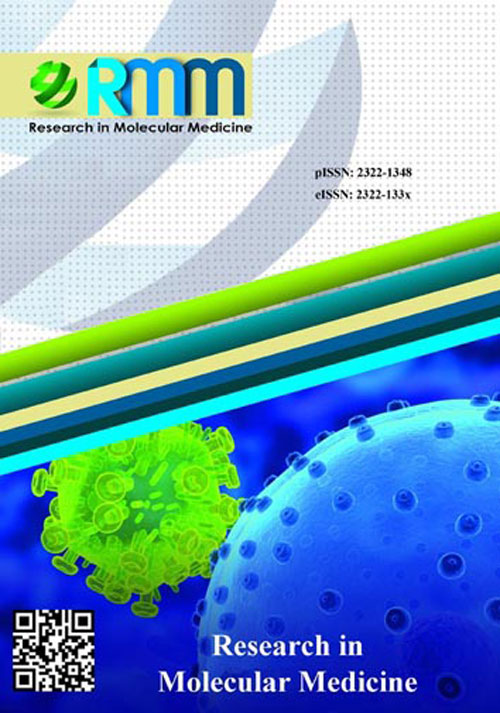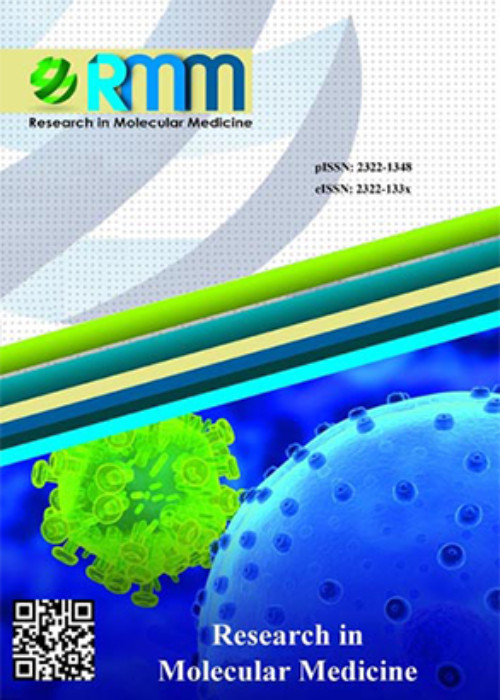فهرست مطالب

Research in Molecular Medicine
Volume:4 Issue: 4, Nov 2016
- تاریخ انتشار: 1396/01/23
- تعداد عناوین: 8
-
-
Pages 1-7BackgroundChronic inflammation and dys-regulation of the immune system mechanisms are now well established as primary triggers of gastric cancer and peptic ulcer disease. Galectin-9 (Gal-9) is a member of the galectin family and known as an inducer of cell aggregation, adhesion and apoptosis. Gal-9 interaction with its main ligand T-cell immunoglobulin and mucin domain protein-3 (Tim-3) leads to the apoptosis of T cells and dys-regulation of the immune responses in different tumors. In the current study, the mRNA expression pattern of Gal-9 was evaluated in gastric biopsies of patients with gastric cancer and peptic ulcer disease.MethodsIn this case control study, gastric biopsies were obtained from 46 patients with gastric cancer, 44 patients with peptic ulcer disease and 41 cases with non-ulcer dyspepsia served as controls who underwent endoscopy for evaluation of their gastric problems. Infection with Helicobacter pylori was determined by rapid urease test for all participants and H&E staining for GC patients. Total RNA was extracted from all gastric tissues and used for cDNA synthesis. Relative expression of Gal-9 mRNA was determined by Real-Time PCR using β-actin as a housekeeping gene.ResultsGal-9 was similarly expressed in all three studied groups. No statistical difference was found for Gal-9 expression between gastric cancer patients and control group (2-ΔCt =0.022 vs 0.0144, p=0.30) and also between peptic ulcer and control groups (2-ΔCt =0.088 vs 0.144, p=0.16). No correlation was found for Gal-9 expression and infection with Helicobacter pylori (2-ΔCt = 0.1 vs 0.129, p=0.51).ConclusionSimilar expression of Gal-9 in gastric tissues from patients with gastric cancer, peptic ulcer and also non-ulcer dyspepsia individuals suggest no possible role of this molecule on tumorigenesis and immunoregulatory mechanisms of these gastric disorders.Keywords: Gastric cancer, Peptic ulcer disease, Galectin-9, Helicobacter pylori
-
Pages 8-14BackgroundHepatic ischemia/reperfusion injury (I/RI) is a multifactorial pathophysiologic process which can lead to liver damage and dysfunction. This study examined the protective effect of dexamethasone on the gene expression of endothelial nitric oxide synthase (eNOS) and endothelin-1 (ET-1) and on the liver tissue damage during warm hepatic I/R.MethodsA total of 32 male Wistar rats was randomly divided into four groups of eight: SHAM: the group receiving saline; DEX: the group receiving dexamethasone (8 mg/kg); I/R: Ischemia-reperfusion insulted group; and DEX I/R: I/R group receiving dexamethasone. After 3 h of reperfusion followed by 60 min of ischemia, serum and ischemic tissue were collected. Serum was used to determine the hyaluronic acid (HA), aspartate and alanine aminotransferases (AST and ALT). To evaluate the eNOS and ET-1 gene expression, the total RNA was extracted from the liver tissue, cDNA was synthesized and real-time PCR was performed. Tissue staining was performed by the Hematoxylin and Eosin stain.ResultsI/R increased serum AST, ALT and HA in I/R group compared with that in the SHAM group (PConclusionsDexamethasone can decline hepatic I/RI by protecting the sinusoidal endothelial glycocalyx and modifying the expression of ET-1. Given that the reactive oxygen species (ROS) are the main cause of glycocalyx degradation and ET-1 is the regulator of hepatic perfusion, thus, dexamethasone has antioxidant properties and helps proper hepatic perfusion after ischemia to maintain.Keywords: Ischemia, reperfusion, glycocalyx, endothelin-1
-
Pages 15-21BackgroundInterferons are some kind of natural cytokines which express in response to a variety of antigens including viral RNA, bacterial products, and tumor proteins. Interferon beta is used in the treatment of autoimmune diseases such as multiple sclerosis. Moreover, this drug inhibits cellular proliferation as well as angiogenesis and as a result, helps to cure cancer. In this research, in addition to cloning the interferon-beta gene along with conserved kozak sequence after the strong eEf1a promoter in the pBud.CE4.1 vector, the expression of this recombinant gene was compared to basal expression in HEK293T cell line using real-time PCR, SDS PAGE and western blot tests.Materials And MethodsIn the beginning, the interferon-beta gene was amplified from the pSVM dhfr vector containing the gene, using primers including BglII and KpnI restriction sites as well as conserved kozak sequence. Then the duplicated gene was digested and inserted in the linear pBud.CE4.1 vector. After ensuring entry of the gene using RFLP, colony PCR and sequencing, the recombinant vector was transfected into E. coli TOP10 competent bacteria. After that, amplified recombinant vector was extracted and transfected into HEK293 cell line.ResultsThe expression of interferon-beta cloned in pBud.CE4.1 vector showed a 79.9-fold increase, in comparison with the basal expression in HEK293T cell line. Moreover, non-recombinant vector transfection has increased the expression of interferon-beta up to 2.87 times in the cell line that is probably due to the existence of the viral promoter in the vector.ConclusionReal-time PCR and protein test results showed that recombinant beta interferon gene had been successfully expressed in HEK293T cell line. In order to produce more of this protein, optimization of various conditions are required for the HEK293T cell line.Keywords: HEK293T cells, Interferon Beta 1a, Real-time PCR, SDS PAGE, Western blot
-
Pages 22-27BackgroundNorth of Iran is amongst high incidence rate areas of gastric carcinoma where environmental carcinogenic compounds especially agricultural pesticides are massively used. Cytochrome P450 2E1 (CYP2E1) enzyme metabolically activates a large number of low molecular mass xenobiotics. The polymorphic nature of cyp2E1 gene control elements is associated with interindividual differences for toxicity of its substrates and may be responsible for increased gastric cancer susceptibility. The current study investigated the allelic frequencies of cyp2E1 gene RsaI/PstI polymorphisms and its association with gastric cancer risk in north of Iran.Materials And MethodsThis case-control study comprised of 120 gastric cancer patients and a group of 135 healthy individuals as control. Genotyping of cyp2E1 gene PstI/RsaI polymorphisms were carried out by PCR-RFLP method. Statistical analyzes were performed by Logistic regression model and PResultsTNM classification showed that most patients (88%) were in advanced stages when the disease was diagnosed. Frequencies of C1C1 and C1C2 genotypes of PstI/RsaI polymorphisms were 96 and 4% in case, and 99 and 1% in control group, respectively whereas homozygote C2C2 genotype was not observed in any of the subjects. In Logistic regression model no significant association was found between RsaI/PstI allelic variants and gastric cancer risk (p =0.443, OR=0.386, CI=0.034-4.395). Furthermore, no significant correlation was seen between genotypic frequencies and clinicopathological characteristics.ConclusionsNo significant association was found between cyp2E1 gene PstI/RsaI allelic variants and gastric cancer risk or clinicopathological characteristics of gastric cancer patients in north of Iran.Keywords: cyp2E1 gene, Gastric Cancer, PstI, RsaI polymorphism, Northern Iran
-
Pages 28-37BackgroundFormation of secondary structure such as DNA hairpins or loops may influence molecular genetics methods and PCR based approaches necessary for genetic engineering, in addition to gene regulation.Materials And MethodsA polymerase chain reaction with splice overlap extension (SOE-PCR) was used to create fully synthetic 1F5 chimeric anti-CD20 heavy- and light-chain genes. The chimeric genes were cloned into the pCR-Blunt II-TOPO vector following by cloning into the pBudCE4.1 expression vector. Prediction of secondary structure was performed with the Vienna RNAfold webserver. PCR and sequencing across the predicted secondary structure of chimeric 1F5 heavy-chain gene was performed with multiple protocols for standard and GC-rich templates.ResultsIn our attempt to design vectors aimed to generate mouse-human chimeric antibody against CD20 (1F5), we found that the coding sequence of 1F5 chimeric heavy-chain gene constructed by SOE-PCR was resistant to polymerase during both PCR and sequencing reactions. Furthermore, we were also unable to analysis some positive transformants by restriction enzyme digestion. Encountering such difficulties to identify the cloned anti-CD20 chimeric heavy-chain gene, we found that the chimeric heavy-chain sequence is highly GC-rich and predicted to form a stable secondary structure.ConclusionIn conclusion, for the first time, we reported several difficulties with production of therapeutic chimeric 1F5 anti-CD20 antibody due to a predicted hairpin cluster correlates with barriers to PCR, sequencing and possibly restriction analysis. Our findings provide a probable note for researchers experiencing technical difficulties with construction of chimeric anti-CD20 antibody 1F5 gene vectors and also with other genes and molecular biology techniques requiring PCR-based method or restriction enzyme analysis.Keywords: 1F5, Monoclonal antibody, Chimeric gene, SOE-PCR, Secondary structure
-
Pages 38-44BackgroundWarfarin is a common anticoagulant drug that has a narrow therapeutic index; higher dose causes excessive bleeding and lower dose leads to cerebrovascular clotting and stroke in patients. Genetic factors that have been associated with warfarin response are the genes of cytochrome P450 2C9 (CYP2C9), which metabolize the more active S-enantiomer of warfarin, and vitamin K epoxide reductase (VKOR), the target site for warfarin. The present study was conducted to investigate the association between CYP2C9*2, CYP2C9*3 and VKORC1 (-1639 G>A) polymorphisms with warfarin daily dose on 118 Iranian patients under warfarin treatment.Materials And MethodsThis study is comprised of 118 Iranian patients on warfarin treatment who attended the PT Clinic. Genotyping of CYP2C9*2, CYP2C9*3 and VKORC1 (-1639 G>A) was performed by PCR-RFLP method. Multiple regression model was performed for statistical analyses and PResultsThe allelic frequencies of CYP2C9*2 and CYP2C9*3 were 19% and 7%, respectively. Patients with ≥1 CYP2C9 variant allele had a significantly lower mean warfarin daily dose compared with patients with the wild-type genotype. The allelic frequencies of VKORC1 were 14.4%, 57.6% and 27.9% for GG, GA, and AA genotypes, respectively. The mean (SD) warfarin daily dose in patients with the VKORC1 (1639) GG genotype was significantly higher than GA and AA patients.ConclusionCYP2C9*2, CYP2C9*3 and VKORC1 (-1639 G>A) polymorphisms had significant association with warfarin daily dose. Furthermore, the daily warfarin dose was not influenced by age, height, weight and sex.Keywords: CYP2C9*2, CYP2C9*3, VKORC1, Warfarin, RFLP
-
Pages 45-50BackgroundType 1 diabetes (T1D) is caused by cell-mediated autoimmune attack on pancreatic beta-cells. Previous studies highlight the role of microRNAs (miRNAs) in the pathogenesis of T1D. MiRNAs are small non-coding RNAs involved in the regulation of gene expression post-transcriptionally. In this work, miR-18b was chosen and the differential expression of it was measured between T1D patients and healthy controls from Isfahan population.Materials And MethodsMiR-18b was selected using Bioinformatics studies by miRWalk software. 22 T1D patients and 18 healthy controls from Isfahan population were enrolled in this study. Total RNA of the peripheral blood mononuclear cells (PBMCs) samples were extracted. After cDNA synthesis, the expression profile of miR-18b quantified by means of qPCR method in patients and controls. Finally the results were statistically analyzed.ResultsIn this study despite our hypothesis, the expression levels of miR-18b didnt show any significant difference between T1D patients and healthy controls (p value: 0.145).ConclusionDue to the results of our experimental analysis, it seems that miR-18b doesnt have any association with T1D disease in Isfahan population.Keywords: type 1 diabetes (T1D)_microRNA_miR-18b_qPCR_miRWalk
-
Pages 51-55BackgroundThe aim of this study was to evaluate the effect of Ramadan fasting on SIRT1 mRNA expression in healthy men.Islamic Ramadan fasting is a holy religious ceremony that has many spiritual benefits. Additionally, it can be considered as the equivalent of calorie restriction that may affect physical health. The results of previous studies revealed that calorie restriction increases the lifespan in laboratory rodents via increasing the expression of a histone deacetylase named SIRT1. Additionally, SIRT1 is known for its anti-inflammatory properties.Materials And MethodsOverall, 43 men volunteered for participating in this one-group before and after (self-controlled) study. Two mL blood samples were taken prior to fasting and at the end of the 30th day of fasting. Routine biochemical tests and SIRT1 mRNA expression analysis were performed.ResultsCholesterol and low-density lipoproteins increase, however, high-density lipoproteins level decreased after Ramadan fasting. The analysis of real-time PCR results revealed that SIRT1 mRNA expression in human peripheral blood mononuclear cells increased 4.63 fold in fasting state in comparison with non-fasting state.ConclusionRamadan fasting has a significant effect on SIRT1 gene expression. Considering the immunosuppressive and anti-inflammatory properties of SIRT1, further studies are needed to evaluate the effects of SIRT1 up-regulation on the autoimmune and inflammatory diseases during Ramadan fasting.Keywords: Ramadan fasting, Calorie restriction, Sirtuin


